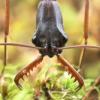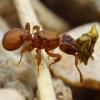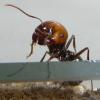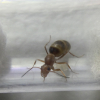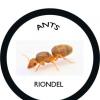Here I'll be explaining how to take the normally monogynous species Odontomachus bauri and make a polygynous colony out of them. This is all purely based on my experience and is by no means a scientific guide. It may never work for you.
Now first I'll say that you should by no means expect this to work, and there are many finicky things completely out of your control that can go wrong, you can't change the attitude of the queens towards each other. In many, many cases the queens will work out a pecking order, with only one of the queens reproducing, or one will kick out or even kill the rest. I have tried this many times and now finally got it (i. e., multiple queens reproducing peacefully) to work. If you only have one or a few queens I would not recommend trying this. In South Florida I literally found hundreds of queens this year, so I had a lot of room for trial and error. The maximum number of queens I could get to found together was 3, you should have no trouble getting two to found. So why go to all this trouble to get ONE extra queen? Well,
If you do get this to work, you can have an immense, and therefore much more outgoing and interactive colony, many times the size of a normal one. Once the colony gets large you shouldn't encounter problems, most of the difficulties are in the founding stage. Now this is how you do it:
Step 1: Gather two queens that already get along.
In many cases Odontomachus queens will found in pairs and sometimes (!!!) stay together for life. There is a small but existent chance that you will find two Odontomachus queens paired up. You may also be able to pair separate queens but this has a lower chance of working long-term.
Step 2: Brood boost with alates.
In my first odontomachus colony I attempted to brood-boost them and accidentally did so with alates, which is how I found out about this method. You have to brood boost them with male and female alates from separate colonies. That means you need three colonies to be able to do this. Additionally, you need to do this before the colony gets workers. This is difficult since Odontomachus, males, females, and workers are all around the same size and they make cocoons when they pupate, so it is very difficult to tell what is inside the pupa. You'll need to rely on mostly dumb luck to be able to complete this step.
Step 3: Feed. A lot.
You have to feed them as much as they'll take for some reason. They just don't do this unless they're drowning in food. My guess is that this allows the queens (which are similar to workers, hunt, and have a worker-like mentality when founding) to focus more on long-term reproductive aims and perhaps feel more secure.
Step 4: Wait for the alates and the males to mate.
For some reason males have no scruples about mating in-nest and both virgin and already-mated queen are receptive (to a certain extent, usually not performing any more than 2 or 3 matings). It's possible to augment the reproductive capabilities of your already-mated queens by brood-boosting them with males from another colony, who will mate with the queens, giving them more sperm. What you want to happen is that the males will mate with both queens and alates until both of them have reached maximum reproductive capacity. The alates will take off their wings and now the hard part begins.
Step 5: Move them out.
You will need to move them out of their initial test-tube, since it will probably be overflowing in trash anyway. Settling into a new environment together helps acclimate the old queens and the new. Do this BEFORE the newly mated queens shed their wings.
Step 6: Bite your nails.
You can't really do anything else at this point. It's all up to the queens. If they fight beyond a snap or two, separate them. If new queens are driven away, push them gently back, but if they fight again, separate them. Signs of aggression should be red flags.
Like I said, this rarely works, but IME this is by far the best way to do it if you decide you want more than two queens. If you don't or you only have one or a few queens, feel free to not waste time and queens on this.
I have no idea how or if this works on other odontomachus species by the way.


